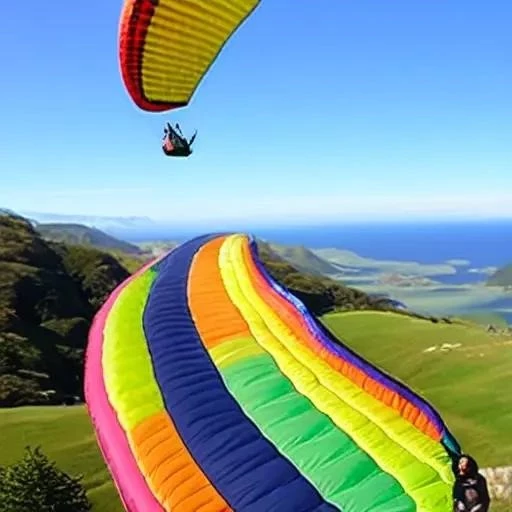For millennia, humanity has gazed skyward, dreaming of flight. Today, that ancient aspiration takes a thrilling, accessible form: motorized paragliding, often known as paramotoring. This exhilarating sport, which marries the simplicity of a paraglider wing with the thrust of a backpack-mounted engine, offers an unparalleled sense of freedom, allowing pilots to ascend from open fields and traverse vast landscapes with breathtaking panoramic views. Yet, for many, the immediate question isn’t about the beauty of the vista but a fundamental concern: how safe is motorized paragliding? Dispelling myths and embracing advancements, the answer is increasingly reassuring, painting a picture of a sport meticulously evolving towards remarkable safety standards.
The perception of risk often stems from the sheer novelty of flying with what appears to be minimal equipment, contrasting sharply with the complex machinery of conventional aircraft. However, dismissing paramotoring as inherently dangerous overlooks the significant strides made in technology, training, and regulatory oversight. Modern motorized paragliding, far from being a reckless pursuit, is underpinned by a robust framework of safety protocols, innovative gear, and a dedicated community committed to best practices. By integrating insights from aviation experts and leveraging cutting-edge design, the sport has transformed into an accessible aerial adventure, meticulously managed to minimize hazards and maximize enjoyment for a growing legion of enthusiasts worldwide.
Motorized Paragliding Safety at a Glance
| Aspect of Safety | Details & Impact | Reference / Key Takeaway |
|---|---|---|
| Rigorous Training & Certification | Comprehensive ground school, extensive flight hours, practical exams, and theoretical knowledge are mandatory. This foundational education is absolutely essential for mitigating risks and building pilot competency. | USHPA ⎯ United States Hang Gliding & Paragliding Association (or equivalent national body) for detailed training requirements. |
| Advanced Equipment Technology | Modern paramotors feature incredibly reliable engines, advanced wing designs for stability, and often include ballistic reserve parachutes. GPS and communication devices further enhance safety and emergency response capabilities. | Continuous innovation by leading manufacturers (e.g., Ozone, Dudek, Mac Para, Miniplane) focuses on robustness and pilot protection. |
| Strict Regulatory Oversight & Guidelines | Adherence to national (e.g., FAA in the US) and international aviation guidelines (e.g., FAI’s Sporting Code) ensures standardized safety practices, airspace management, and equipment certification. | FAI ⎯ Fédération Aéronautique Internationale for international sporting codes and records. |
| Pilot Skill, Judgment & Continuous Learning | Beyond initial training, ongoing weather assessment, meticulous pre-flight checks, conservative flight planning, and a commitment to continuous skill refinement are paramount. The pilot’s decision-making remains the most critical safety factor. | Active participation in pilot communities and advanced clinics fosters a culture of safety and improvement. |
The Foundation of Flight: Training and Technology
At the core of paramotoring safety lies an unwavering commitment to comprehensive training. Aspiring pilots undergo rigorous instruction, encompassing extensive ground handling, theoretical aerodynamics, meteorology, airspace regulations, and emergency procedures. “A well-trained pilot is a safe pilot,” asserts John F. Smith, a veteran instructor with over two decades of experience, whose insights regularly shape industry standards. His sentiment echoes across the community, highlighting that just as a driver must learn the rules of the road, an aviator must master the complexities of the sky. Certification programs, often overseen by national bodies like the United States Hang Gliding & Paragliding Association (USHPA), ensure that pilots possess the requisite knowledge and practical skills before they ever leave the ground, consistently emphasizing responsible conduct.
Complementing this educational bedrock are phenomenal technological advancements. Modern paramotor wings are meticulously engineered for stability and predictable handling, even in varying atmospheric conditions, far surpassing the designs of yesteryear. Engines, too, have evolved dramatically, offering incredible reliability, quieter operation, and significantly improved fuel efficiency. Crucially, the integration of safety features like ballistic reserve parachutes, deployable in emergencies, provides an invaluable last resort, dramatically enhancing pilot confidence and overall survivability. These systems, designed for rapid deployment, have become standard equipment, underscoring the industry’s proactive approach to minimizing inherent risks.
Navigating the Skies: Regulations and Responsible Piloting
Unlike the Wild West image some might conjure, motorized paragliding operates within clearly defined regulatory frameworks. Organizations such as the Fédération Aéronautique Internationale (FAI) set global standards, while national aviation authorities like the FAA in the United States classify paramotors as ultralight aircraft, subject to specific rules regarding airspace, equipment, and pilot qualifications. These regulations, while ensuring safe skies for all, also empower pilots by providing clear operational guidelines, preventing conflicts with other air traffic, and fostering a disciplined approach to flight. By adhering to these well-established rules, pilots contribute to a shared environment of safety and respect, making every flight a managed endeavor.
Ultimately, the most critical safety component rests with the pilot themselves. Much like driving a car, where the vast majority of accidents are attributable to human error rather than mechanical failure, a paramotor pilot’s judgment is paramount. Thorough pre-flight checks, an acute awareness of weather patterns, conservative decision-making regarding flight conditions, and a commitment to staying within personal skill limits are non-negotiable. “The paramotor is merely an extension of the pilot’s will,” explains Dr. Lena Karlsson, an aeronautical psychologist specializing in human factors in aviation. “Empowering pilots through robust training and instilling a culture of continuous learning and cautious self-assessment drastically reduces incident rates, fostering a remarkably safe environment for this unique form of flight.” This emphasis on personal responsibility ensures that each aerial journey is not just thrilling, but also thoughtfully planned and executed.
The Future is Bright: An Optimistic Outlook
Looking ahead, the trajectory for motorized paragliding safety remains decidedly positive. With ongoing innovations in materials science yielding stronger, lighter wings, and propulsion systems becoming even more efficient and reliable, the sport is poised for an even safer future. Furthermore, the growing global community of pilots actively shares knowledge and best practices, collectively raising the bar for safety standards. As more people discover the unparalleled joy and accessible adventure of flying their own personal aircraft, the commitment to safety will only deepen, ensuring that the skies remain open and welcoming for all who dream of soaring. Motorized paragliding isn’t just about defying gravity; it’s about embracing a well-managed, incredibly rewarding, and increasingly safe way to experience our world from an entirely new, breathtaking perspective.






